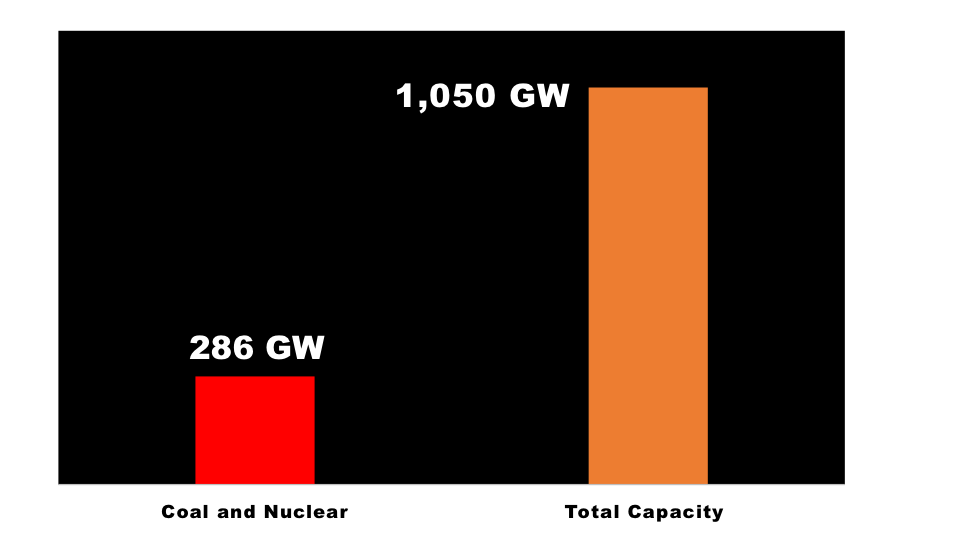Everyone agrees that we need an electricity grid that is not only reliable but also resilient. PJM says that resilience “relates to preparing for, operating through and recovering from a high-impact, low-frequency event.”[i] Fuel security is essential to resilience because it enables the grid to absorb and recover quickly from manmade or natural disturbances that could have disastrous consequences. Having a large supply of coal ― which ranged from 71 to 104 days of burn last year ― stockpiled at coal-fired power plants provides resilience against high impact, low frequency disturbances because on-site fuel supplies minimize the potential for fuel supply disruptions.[ii]
The debate about resilience and fuel security has led to assertions that we think are misleading or wrong, so we thought it would be helpful to offer a different perspective. This is the first of a series of short pieces that we hope will correct the record.
“There is no resilience or reliability problem.”
First, this claim is based on the grid today, not the future when more fuel-secure sources will be replaced with fuel-insecure resources. For example, EIA projects that fuel-secure coal-fired and nuclear power plants will comprise slightly more than one-fourth of the nation’s electric generating capacity by 2025 (chart below).[iii]
Second, assertions like this often conflate resilience and reliability. As the National Academy of Sciences said, the two are not the same.[iv] Generally speaking, the grid today is reliable based on objective metrics, such as loss of load expectation (LOLE) and other quantitative criteria. By contrast, there are no agreed-on criteria or metrics for determining whether the grid is resilient. In fact, the Federal Energy Regulatory Commission initiated a proceeding in January to define what resilience means and determine whether the bulk power system in RTO/ISO regions is resilient.[v] Also, PJM and ISO-NE are conducting fuel security studies because of the importance of fuel security to resilience.[vi]
Here is a sampling what others have said about resilience and fuel security ―
- “While the PJM grid also remains fuel secure … the potential for continued evolution of the fuel mix underscores concerns … about the need to examine the long-term resilience of the grid …” (PJM, May 2017)
- “Premature retirements of fuel secure baseload generating stations reduces resilience to fuel supply disruptions.” (NERC, May 2017)
- “In New England, the most significant resilience challenge is fuel security ….” (ISO-NE, April 2017)
- “Recent and announced retirements of fuel-secure electric generation capacity across the United States are undermining the security of the electric power system because the system’s resilience depends on these resources.” (National Security Council draft memo, May 2018)
- “The issue is not whether our Nation’s electric system has operated or is currently operating a high level of reliability … rather it is whether the Nation’s electric power system is adequately prepared … to withstand a high-impact electricity system disruption caused by an attack, natural disaster, or other incident.” (Ibid)
ACCCE asked Quanta Technology to analyze the potential effects of accelerated coal retirements and lack of fuel security, using the 13-state PJM grid as a case study. Quanta concluded that the PJM grid is reliable under current conditions. However, reliability criteria would be violated, and the PJM system would lose its resilience if coal retirements accelerate.[vii] This is an example of the kind of analysis we hope that others responsible for grid reliability and resilience will undertake.
Figuring out what to do about resilience and fuel security is likely to take three to five years based on past experience and our conversations with grid operators, NERC and others. In the meantime, an additional 45,000 MW of fuel-secure coal-fired generation are expected to retire.[viii] Consequently, it makes sense to take steps immediately to defer the retirement of fuel-secure electricity sources until we know whether the grid is resilient and what to do if it’s not. We plan to discuss some of those steps in an upcoming paper.
[i] PJM, PJM’s Evolving Resource Mix and System Reliability, March 30, 2017.
[ii] EIA, Electricity Monthly Update, “Electric Power Sector Coal Stocks: March 2018,” release date May 28, 2018. During March 2018, coal burn was 90 days for bituminous coal and 99 days for subbituminous coal.
[iii] EIA, Annual Energy Outlook 2018.
[iv] National Academy of Sciences, Enhancing the Resilience of the Nation’s Electricity System, 2017.
[v] Grid Resilience in Regional Transmission Organizations and Independent System Operators, Docket No. AD18-7-000, 2018
[vi] PJM, Valuing Fuel Security, April 30, 2018.
[vii] Quanta Technology, LLC, Ensuring Reliability and Resilience – A Case Study for the PJM Power Grid, April 23, 2018.
[viii] ACCCE, Retirement of U.S. Coal-Fired Electric Generating Units ― Status as of May 1, 2018.

